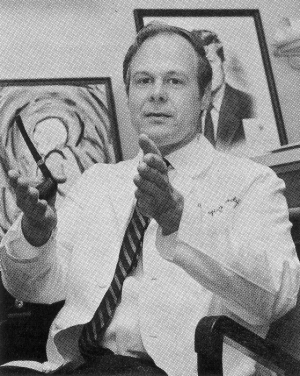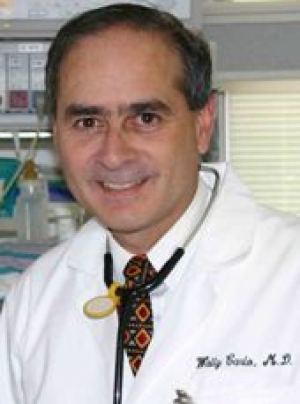-
Beginnings of the Division
The Division of Neonatology was born with the arrival of Dr. George Cassady in July of 1964 as the chief of perinatology and director of nurseries after completing training at Duke University, Harvard University and the NIH. His final year of training was in neonatal physiology at Harvard University under the direction of the legendary Clement Smith. In his own words upon his arrival, Dr. Cassady said, “There were four nurseries on the 5th floor of Hillman – two ‘white’ on one side and two ‘colored’ on the other side of the delivery rooms – ‘regular’ & ‘premature’ nurseries. My first task was to convert the ‘colored’ nurseries into a single ‘High Risk’ nursery which had about 1,110 admissions during its initial year of operation. The ‘white’ nurseries became the ‘Well Baby Nursery’. The total deliveries was about 3,500 that year. Many threats to me and my family from the KKK for the ‘integration’!!”
During those early years, Dr. Cassady had a number of trainees, there was no official neonatal-perinatal fellowship then, and junior faculty but no official and funded faculty associates until 1980. Several of his early associates went on to significant leadership positions at other institutions in the US and abroad.
Dr. Joseph Philips joined the faculty as an assistant professor in 1980 after his fellowship in neonatal-perinatal medicine at the University of Florida where he studied in the laboratory of Sidney Cassin, Ph.D., a pioneer in the field of the pulmonary transitional circulation. Dr. Philips established the Perinatal Physiology Research Laboratory and continued work in the field of pulmonary transitional circulation and persistent pulmonary hypertension of the newborn. This laboratory continues today under the direction of Dr. Namasivayam Ambalavanan who arrived as a fellow in 1993 and remained on faculty upon completion of training and is now professor of Pediatrics with significant NIH and other agency funding.
Dr. Cassady and Dr. Philips were funded in the initial round of funding from National Institute of Child Health and Human Development (NICHD) for the Neonatal Research Network. The division’s participation in this important national, multi-centered consortium, which has produced numerous seminal studies, continues to the present day.
-
Dr. Carlo Becomes Division Director
Dr. Waldemar (Wally) Carlo arrived as director of the Division of Neonatology in 1991. He continued membership in the NICHD Neonatal Research Network and subsequently gained membership in the NIH-sponsored NICHD Global Network for Women’s and Children’s Health Research. Dr. Carlo has published hundreds of scholarly works and has positively affected healthcare for infants worldwide. He has received numerous prestigious awards including the Douglas K. Richardson Award in Perinatal and Pediatric Healthcare from the Society for Pediatric Research and the Virginia Apgar Award from the American Academy of Pediatrics.
The original newborn nurseries were located on the 5th floor of the New Hillman Building. They underwent extensive remodeling in the late 1980 to encompass space on the 4th and 5th floors. However, as census increased, satellite step-down nurseries were established in the adjoining Jefferson Tower building. The first NICU opened at Children’s Hospital of Alabama in the late 1980s under the direction of Dr. Raymond Lyrene. After several years the Children’s nursery expanded into two separate units. In 1991, the division established a community group to provide neonatology services to local hospitals outside the UAB and Children’s systems. This group has grown to cover most NICUs in the city and surrounding area.
-
The Division Continues to Grow
The ever-increasing census of the UAB RNICU led to its relocation to the Women and Infant’s Center in 2010. This state-of-the-art, all private room NICU has a capacity of 125 infants. It is the largest all private room NICU in the country and is one of the largest of any kind. Two state-of-the-art 25 bed NICUs opened in the Benjamin Russel Hospital at Children’s of Alabama in 2012. Combined, these NICUs constitute the largest academic neonatology service in the nation.
An accredited fellowship in neonatal-perinatal medicine was established in the late 1980s. More than 75 neonatologists from all over the world have been trained since the late 1970s. Many of these have assumed positions at prestigious institutions including chairs of pediatrics and directors of neonatology, while others have pursued careers in private practice.
The faculty currently numbers 22. Many current faculty members are NIH funded or are working towards this goal. Others are focused on quality improvement or simulation.
The division has made many significant contributions to the understanding of neonatal pathophysiology and disease over the years. Dr. Cassady made seminal contributions to our understanding of fluid and electrolyte physiology of the fetus and neonate while at UAB. Dr. Philips made important contributions to our understanding of the physiology of the transitional pulmonary circulation and the elucidation of the mechanism whereby Group B Streptococcus causes pulmonary hypertension in the newborn. More recently, the division has become a powerhouse of investigation into the pathophysiology and management of bronchopulmonary dysplasia. Additional areas of study include the pulmonary microbiome, the neonatal brain and the role of mitochondria in neonatal disease.
-

Division Leadership
Division Directors
George Cassady-1964 to the late 80s
Photo credit: UAB ArchiveWally Carlo- 1991 to present
-
Prominent Faculty
-

George Cassady
Dr. George Cassady, a native of California, joined the faculty of the Department of Pediatrics in 1964 as head of the Division of Neonatology. Dr. Cassady graduated from Duke Medical School in 1958 and completed his residency training at the same institution in 1960. He then served for two years as a clinical associate and medical investigator in the genetics unit at the NIH. From 1962 to 1964 he was a senior resident in pediatrics and fellow in neonatal physiology with Dr. Clement Smith at Harvard University.
When Dr. Cassady joined the Department in 1964 the neonatology unit at University Hospital was located on the third and fourth floors of the New Hillman Building on the corner of 20th Street and 7th Avenue South. By 1980, the unit had grown to 21 beds for premature/sick neonates with an average daily census of 19, and 95 beds for healthy newborns with a daily census of 47.
Dr. Cassady was an excellent leader who was not afraid to ruffle feathers in order to get things done. He had superb clinical skills and was a great motivator and teacher. He did not settle for anything less than excellence and was demanding of himself and his co-workers. He valued research and aggressively pursued funding. The culmination of his efforts occurred when he secured funds from the National Institute of Child Health and Human Development (NICHD) for the research network of neonatal intensive care units. He was funded on the first cycle, one of only seven institutions. This grant has been renewed multiple times and is still active today. The division under his direction provided exemplary education and a continuous flow of quality research at both basic and clinical levels. The fellowship program established by Dr. Cassady soon after his arrival at UAB has produced excellent clinical and basic research individuals in the field of neonatology, populating both academic medicine and private practice.
Dr. Cassady, unhappy with the unacceptably high rate of neonatal and infant mortality in Alabama, worked tirelessly to address the problem by working with the State Medical Association, the Alabama Chapter of the American Academy of Pediatrics (AAP) and the State Department of Public Health. He appealed to leaders in the community and asked for ideas and the collaboration of physicians for the purpose of reducing the tragic and unnecessary toll of infant deaths in Alabama. Since his call for action was issued in the State Medical Association Journal in 1968, neonatal outcomes have improved substantially, but unfortunately Alabama still ranks at the bottom of infant and newborn mortality statistics.
During his time as division director, Dr. Cassady recruited several neonatologists. Among them, Drs. David Wirtschafter, Joseph B. Phillips, Elaine Barefield, and others. George Cassady retired in 1989 and returned to California where he became director of neonatology and chairman of the Department of Pediatrics at Children’s Hospital of San Francisco.
-

Wally Carlo
In 1991, the department was successful in recruiting Dr. Wally Carlo from Rainbow Children’s Hospital in Cleveland to lead the Division of Neonatology. The arrival of Dr. Carlo was one of the most significant additions to the faculty because of his strong leadership skills and “can do attitude.” He immediately set up an open-door policy for all neonates from any referring hospital. He committed himself to the highest standards of care, strong research and collaboration with institutions across the USA and abroad. Dr. Carlo successfully secured a multi-institutional NIH grant for the Neonatal Network, plus many other grants, to support his and his collaborators research. He has become an internationally renowned neonatologist for his landmark studies in Zambia, India and Latin America. Dr. Carlo also created a system whereby a group of neonatologists in his division care for all neonates born at six other community hospitals, allowing for high standard of care and judicious use of resources. This model is still operative today and transformed the Neonatology Division into one of the top such units in the country in terms of productivity per faculty, size of research portfolio, international recognition and overall reputation.
-
Other prominent faculty
Numerous faculty members have come and gone over the years. A significant number have assumed leadership roles in prominent academic institutions upon leaving UAB. An incomplete listing includes Drs:
-George Cassady who went on to lead several divisions of neonatology and to hold other important leadership positions before his retirement.
-David Wirtschafter who took a prominent leadership position with Kaiser-Permanente,
-Clinton Joiner who moved first to Cincinnati and is now the Aflac Children’s Endowed Chair for Hematology, Director, Section of Hematology and Vice Chair for Research in the Department of Pediatrics at Emory University
-Siddhartha Tan who is division chief of Neonatal and Perinatal Medicine at the Detroit Medical Center’s Children’s Hospital of Michigan and Hutzel Women’s Hospital
-Robert Schelonka who is chief of Neonatology at Oreqon Health Sciences University
-Lance Prince who is now chief of Neonatology at UC San Diego
-Akhil Maheshwari, Josephine S. Sutland Professor of Newborn Medicine, Director, Eudowood Division of Neonatology and Vice-Chair (Integration), Department of Pediatrics, Johns Hopkins University.
-